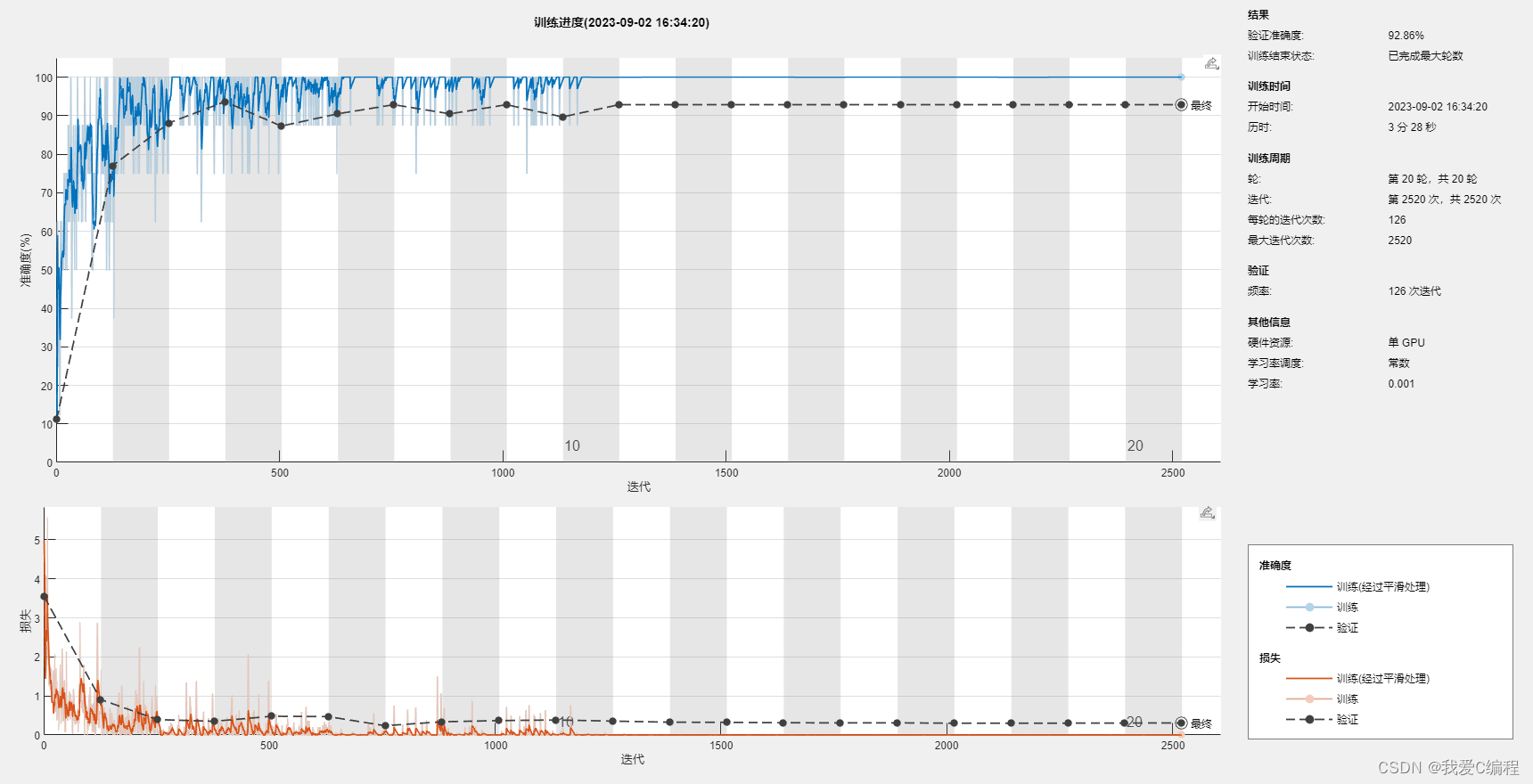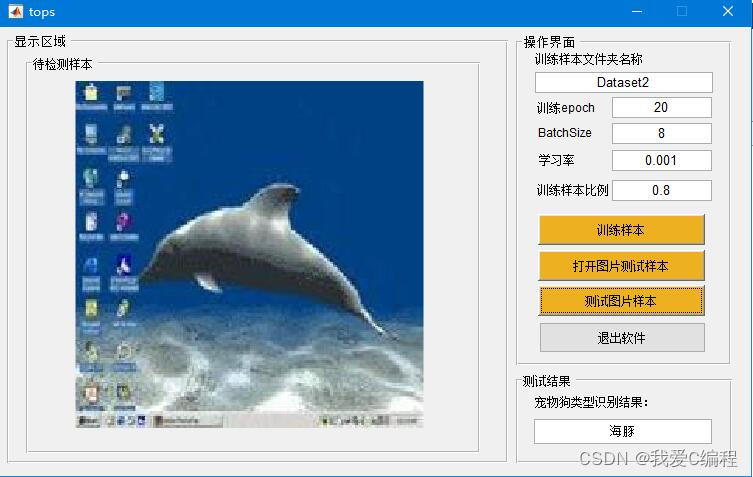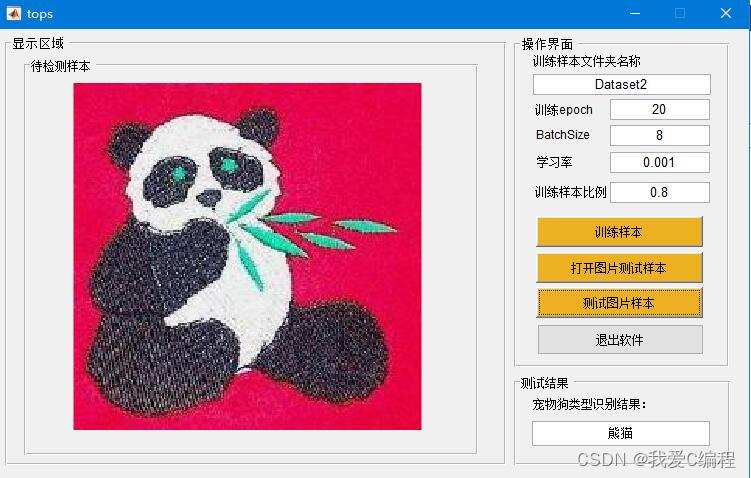目录
1.算法仿真效果
matlab2022a仿真结果如下:








2.算法涉及理论知识概要
基于深度学习网络的动物识别系统是一种利用深度学习技术来进行动物识别和定位的系统。这种系统的工作原理是,通过使用深度神经网络对图像或视频进行分析,以识别出其中的动物并确定其位置。
深度学习网络,特别是卷积神经网络(CNN),是这个系统的核心。CNN是一种特别适合处理图像数据的神经网络,其通过一系列的卷积层、池化层和全连接层来提取和识别图像中的特征。对于动物识别系统,CNN需要被训练来识别各种动物的特征,包括形状、颜色、纹理等。
系统的训练过程通常需要大量的图像数据。首先,需要收集各种动物的图像,包括各种角度、光线、背景等。这些图像经过预处理后,会被用作训练集来训练CNN。训练的过程是通过反复迭代输入图像和对应的标签,不断调整CNN的权重,以使得CNN在给定的任务(动物识别)上达到最佳的性能。
训练好的CNN模型可以识别出训练集中出现的动物,并且能够将其在图像中的位置标注出来。这个过程涉及到图像分割和物体检测技术。一般来说,CNN会输出一个包含动物位置的边界框(bounding box)和一个动物的分类标签。
训练好的模型可以集成到各种应用程序中,如摄像头监控系统、图像编辑软件、游戏、安全系统等。用户可以通过上传图片或视频,或者使用实时摄像头来获取动物识别和定位的结果。系统还可以提供可视化结果,比如将识别出的动物标注在原图上,或者生成一个包含动物信息的表格。
总的来说,基于深度学习网络的动物识别系统是一种强大的工具,可以帮助人们更好地理解和保护动物,同时也为科研、安全、娱乐等领域提供了新的可能性。
CNN模型通常包括以下几个主要部分:
(1) 输入层:用于接收输入的图像数据。
(2) 卷积层:通过一系列的卷积操作来提取图像的特征。
(3) 池化层:对特征进行降采样,以减少计算量和避免过拟合。
(4) 全连接层:将提取的特征用于最终的分类和定位任务。
-
损失函数和优化器
在训练CNN模型时,需要定义一个损失函数来衡量模型的错误程度。常用的损失函数包括交叉熵损失(用于分类任务)和均方误差损失(用于回归任务)。优化器则用于更新模型的权重,以使得损失函数最小化。常见的优化器包括随机梯度下降(SGD)、Adam等。 -
数据增强和预处理
为了提高模型的性能,通常需要对训练数据进行增强和预处理。数据增强可以通过旋转、缩放、裁剪等操作来增加数据量。预处理则包括归一化、去噪等操作,以使得数据更符合模型的输入要求。 -
模型优化技术
为了进一步提高模型的性能,可以采用一些优化技术,如批量标准化(Batch Normalization)、dropout(用于防止过拟合)、早停(early stopping)等。 -
目标检测算法
在进行动物定位任务时,可能需要使用到一些目标检测算法,如YOLO、Faster R-CNN等。这些算法可以在图像中检测出物体的位置和类别,为动物识别系统提供输入。
3.MATLAB核心程序
% --- Executes just before tops is made visible.
function tops_OpeningFcn(hObject, eventdata, handles, varargin)
% This function has no output args, see OutputFcn.
% hObject handle to figure
% eventdata reserved - to be defined in a future version of MATLAB
% handles structure with handles and user data (see GUIDATA)
% varargin command line arguments to tops (see VARARGIN)
% Choose default command line output for tops
handles.output = hObject;
% Update handles structure
guidata(hObject, handles);
% UIWAIT makes tops wait for user response (see UIRESUME)
% uiwait(handles.figure1);
% --- Outputs from this function are returned to the command line.
function varargout = tops_OutputFcn(hObject, eventdata, handles)
% varargout cell array for returning output args (see VARARGOUT);
% hObject handle to figure
% eventdata reserved - to be defined in a future version of MATLAB
% handles structure with handles and user data (see GUIDATA)
% Get default command line output from handles structure
varargout{1} = handles.output;
% --- Executes on button press in pushbutton1.
function pushbutton1_Callback(hObject, eventdata, handles)
% hObject handle to pushbutton1 (see GCBO)
% eventdata reserved - to be defined in a future version of MATLAB
% handles structure with handles and user data (see GUIDATA)
global im;
global Predicted_Label;
cla (handles.axes1,'reset')
axes(handles.axes1);
set(handles.edit2,'string',num2str(0));
load gnet.mat
[filename,pathname]=uigetfile({'*.bmp;*.jpg;*.png;*.jpeg;*.tif'},'选择一个图片','F:\test');
str=[pathname filename];
% 判断文件是否为空,也可以不用这个操作!直接读入图片也可以的
% im = imread(str);
% imshow(im)
if isequal(filename,0)||isequal(pathname,0)
warndlg('please select a picture first!','warning');
return;
else
im = imread(str);
imshow(im);
end
II(:,:,1) = imresize(im(:,:,1),[224,224]);
II(:,:,2) = imresize(im(:,:,2),[224,224]);
II(:,:,3) = imresize(im(:,:,3),[224,224]);
[Predicted_Label, Probability] = classify(net, II);
% --- Executes on button press in pushbutton2.
function pushbutton2_Callback(hObject, eventdata, handles)
% hObject handle to pushbutton2 (see GCBO)
% eventdata reserved - to be defined in a future version of MATLAB
% handles structure with handles and user data (see GUIDATA)
% global im;
%
%
%
% [Predicted_Label, Probability] = classify(net, II);
% imshow(im);
%
global im;
global Predicted_Label;
set(handles.edit2,'string',Predicted_Label);
% --- Executes on button press in pushbutton3.
% --- Executes on button press in pushbutton5.
function pushbutton5_Callback(hObject, eventdata, handles)
% hObject handle to pushbutton5 (see GCBO)
% eventdata reserved - to be defined in a future version of MATLAB
% handles structure with handles and user data (see GUIDATA)
clc;
clear;
close all;
function edit1_Callback(hObject, eventdata, handles)
% hObject handle to edit1 (see GCBO)
% eventdata reserved - to be defined in a future version of MATLAB
% handles structure with handles and user data (see GUIDATA)
% Hints: get(hObject,'String') returns contents of edit1 as text
% str2double(get(hObject,'String')) returns contents of edit1 as a double
% --- Executes during object creation, after setting all properties.
function edit1_CreateFcn(hObject, eventdata, handles)
% hObject handle to edit1 (see GCBO)
% eventdata reserved - to be defined in a future version of MATLAB
% handles empty - handles not created until after all CreateFcns called
% Hint: edit controls usually have a white background on Windows.
% See ISPC and COMPUTER.
if ispc && isequal(get(hObject,'BackgroundColor'), get(0,'defaultUicontrolBackgroundColor'))
set(hObject,'BackgroundColor','white');
end
function edit2_Callback(hObject, eventdata, handles)
% hObject handle to edit2 (see GCBO)
% eventdata reserved - to be defined in a future version of MATLAB
% handles structure with handles and user data (see GUIDATA)
% Hints: get(hObject,'String') returns contents of edit2 as text
% str2double(get(hObject,'String')) returns contents of edit2 as a double
% --- Executes during object creation, after setting all properties.
function edit2_CreateFcn(hObject, eventdata, handles)
% hObject handle to edit2 (see GCBO)
% eventdata reserved - to be defined in a future version of MATLAB
% handles empty - handles not created until after all CreateFcns called
% Hint: edit controls usually have a white background on Windows.
% See ISPC and COMPUTER.
if ispc && isequal(get(hObject,'BackgroundColor'), get(0,'defaultUicontrolBackgroundColor'))
set(hObject,'BackgroundColor','white');
end
function edit5_Callback(hObject, eventdata, handles)
% hObject handle to edit5 (see GCBO)
% eventdata reserved - to be defined in a future version of MATLAB
% handles structure with handles and user data (see GUIDATA)
% Hints: get(hObject,'String') returns contents of edit5 as text
% str2double(get(hObject,'String')) returns contents of edit5 as a double
% --- Executes during object creation, after setting all properties.
function edit5_CreateFcn(hObject, eventdata, handles)
% hObject handle to edit5 (see GCBO)
% eventdata reserved - to be defined in a future version of MATLAB
% handles empty - handles not created until after all CreateFcns called
% Hint: edit controls usually have a white background on Windows.
% See ISPC and COMPUTER.
if ispc && isequal(get(hObject,'BackgroundColor'), get(0,'defaultUicontrolBackgroundColor'))
set(hObject,'BackgroundColor','white');
end
function edit6_Callback(hObject, eventdata, handles)
% hObject handle to edit6 (see GCBO)
% eventdata reserved - to be defined in a future version of MATLAB
% handles structure with handles and user data (see GUIDATA)
% Hints: get(hObject,'String') returns contents of edit6 as text
% str2double(get(hObject,'String')) returns contents of edit6 as a double
% --- Executes during object creation, after setting all properties.
function edit6_CreateFcn(hObject, eventdata, handles)
% hObject handle to edit6 (see GCBO)
% eventdata reserved - to be defined in a future version of MATLAB
% handles empty - handles not created until after all CreateFcns called
% Hint: edit controls usually have a white background on Windows.
% See ISPC and COMPUTER.
if ispc && isequal(get(hObject,'BackgroundColor'), get(0,'defaultUicontrolBackgroundColor'))
set(hObject,'BackgroundColor','white');
end
% --- Executes on button press in pushbutton6.
function pushbutton6_Callback(hObject, eventdata, handles)
% hObject handle to pushbutton6 (see GCBO)
% eventdata reserved - to be defined in a future version of MATLAB
% handles structure with handles and user data (see GUIDATA)
Name1 = get(handles.edit7, 'String');
NEpochs = str2num(get(handles.edit8, 'String'));
NMB = str2num(get(handles.edit9, 'String'));
LR = str2num(get(handles.edit10, 'String'));
Rate = str2num(get(handles.edit11, 'String'));
% 使用 imageDatastore 加载图像数据集
Dataset = imageDatastore(Name1, 'IncludeSubfolders', true, 'LabelSource', 'foldernames');
% 将数据集分割为训练集、验证集和测试集
[Training_Dataset, Validation_Dataset, Testing_Dataset] = splitEachLabel(Dataset, Rate, (1-Rate)/2, (1-Rate)/2);
% 加载预训练的 GoogleNet 网络
load googlenet.mat
% 获取输入层的大小
Input_Layer_Size = net.Layers(1).InputSize(1:2);
% 将图像数据集调整为预训练网络的输入尺寸
Resized_Training_Dataset = augmentedImageDatastore(Input_Layer_Size ,Training_Dataset);
Resized_Validation_Dataset = augmentedImageDatastore(Input_Layer_Size ,Validation_Dataset);
Resized_Testing_Dataset = augmentedImageDatastore(Input_Layer_Size ,Testing_Dataset);
...............................................................................
0Y_005m4.完整算法代码文件
V